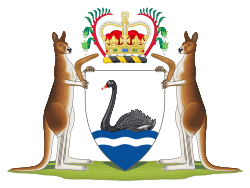Coat of arms of Western Australia facts for kids
Quick facts for kids Coat of arms of Western Australia |
|
|---|---|
 |
|
| Versions | |

State Badge of Western Australia
|
|
| Armiger | Elizabeth II in right of Western Australia |
| Adopted | 17 March 1969 |
| Crest | The Royal Crown between two Kangaroo Paw (Anigosanthos Manglesii) flowers slipped proper. |
| Torse | Or and Sable |
| Blazon | Argent on a base wavy Azure charged with a barrulet wavy Argent a Black Swan naiant proper. |
| Supporters | Red kangaroos bearing boomerangs proper |
| Motto | None |
| Order(s) | None |
The coat of arms of Western Australia is the official symbol of the Australian state of Western Australia. It was given to the state by Elizabeth II, the Queen of Australia, on 17 March 1969. This special permission was given through a document called a royal warrant.
What the Coat of Arms Looks Like
The main part of the coat of arms is the shield. It has a silver background. At the bottom, there are wavy blue and silver lines. A black swan swims on the top blue line. The swan is shown in its natural colors.
The crest is at the top of the shield. It features the Royal Crown in its real colors. The Crown sits on a twisted band of black and gold fabric, called a torse. On either side of the Crown are two kangaroo paw flowers, also in their natural red and green colors.
The supporters are two red kangaroos. They stand on either side of the shield, holding it up. Each kangaroo holds a boomerang in its front paw. The boomerangs do not have any designs on them. The kangaroos stand on a grassy area.
This coat of arms does not have a motto. A motto is usually a short phrase or saying.
The official description of the coat of arms, called the blazon, is very detailed. It describes each part using special heraldry words. For example, "Argent" means silver, "Azure" means blue, "Sable" means black, and "Or" means gold. "Proper" means the item is shown in its natural colors. "Naiant" means swimming.
Even though the original design included a helmet and a cloak (called mantling), these parts are usually left out when the coat of arms is used in Western Australia. This makes it similar to how other Australian states use their coats of arms.
What the Symbols Mean
The black swan is a very important symbol for Western Australia. Early European explorers saw many black swans along the coast. In 1697, a Dutch explorer named Willem de Vlamingh even named the "Swaanerivier" (Swan River) after these birds. Later, in 1826, Captain James Stirling saw about 500 black swans flying over the Swan River. The first British settlement in Western Australia, started in 1829, was often called the Swan River Colony.
The black swan is the official bird emblem of Western Australia. It also appears on the State Badge, which is a black swan shape against a yellow circle. This badge is on the State Flag. The wavy blue and white lines on the shield show the swan swimming in its natural home, like a river or lake.
The Crown represents the monarchy (the King or Queen) in Australia. The black and gold colors of the twisted band (torse) supporting the Crown are the state colors of Western Australia. These colors have been linked to Western Australia since the 1870s.
The kangaroo paw flower (Anigozanthos manglesii) is the official flower emblem of Western Australia. It was adopted in 1960. The flower, along with the black and gold torse, shows the special honor given to the state by having its own coat of arms. It also highlights that Western Australia is a self-governing state.
The red kangaroo (Macropus rufus) is the largest type of kangaroo. It lives in the dry, inland parts of Western Australia. The red kangaroo and the black swan together represent almost the entire state. This shows that the coat of arms covers all of Western Australia. The red kangaroo is often used in Australian symbols, like on the Australian and Northern Territory coats of arms.
The plain boomerangs held by the kangaroos are important. They represent all the Aboriginal peoples of Western Australia. The fact that they have no designs means they stand for everyone.
Even though there is no official motto, an older saying linked to Western Australia was "Cygnis insignis." This is Latin for "distinguished for swans." It's a clever play on words, as "insignis" can also mean remarkable or outstanding. This motto shows the long history of the black swan as a symbol for Western Australia.
Designer
We don't know who the original artist was who designed the coat of arms. However, the symbols used in the design, like the black swan and kangaroo paw, have been used as symbols of Western Australia for a very long time. This suggests the designer knew a lot about the state's history and its special symbols.
See also
 In Spanish: Escudo de Australia Occidental para niños
In Spanish: Escudo de Australia Occidental para niños
Images for kids
-
Emblem used on a 1955 map for the Metropolitan Region Scheme


